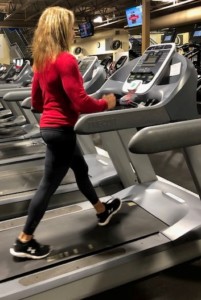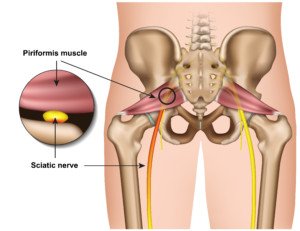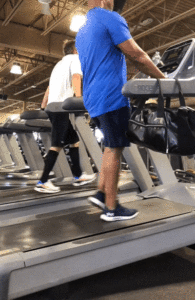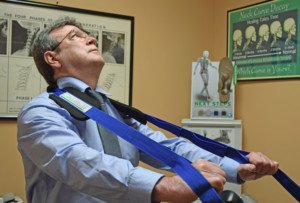
Believe it or not, walking on a treadmill may be the cause of your hip and butt pain, even the tingling that comes with it.
At the epicenter of this problem is the piriformis muscle.
It seems odd that the so very seemingly benevolent action of walking on a treadmill could cause pain in one’s hip and butt, and even at times a numb or tingling sensation.
But there’s a logical explanation. It begins with the biomechanics of walking on a treadmill.
“Using a treadmill in general does not completely simulate the normal walking gait, even without using handrails,” begins Dr. Tom Carpenter, corrective exercise specialist, certified personal trainer and chiropractor, inventor of Stand Corrected™, a portable harness-like stretching tool that helps alleviate back, neck and shoulder pain.
Dr. Carpenter explains, “Instead of engaging the neural pathways and muscles naturally used for normal forward propulsion, the ‘ground’ is moving beneath you with a treadmill, which does, to some extent, change the way the body moves.”
The natural kinetic chain that’s generated by walking is altered when the walking is done on a treadmill.
This doesn’t mean stop using a treadmill. In fact, when I was a personal trainer, I had most of my clients using a treadmill for high intensity interval training or moderate level training.
And I forbad any of them—including beginners, obese and elderly—from holding onto the machine.

Sharon Smith, 71, demonstrates proper walking form on a treadmill; hands off.
None developed butt or hip pain. However, read on to learn how walking on a treadmill can lead to butt or hip pain.
“If the person was already evaluated for more serious neurologic causes [like a tumor] and none were found, I would want to ask them some questions such as when did the symptoms first appear?
“What activities aggravate it/relieve it? Did it happen during a particular activity or was the onset gradual?
“What’s the quality of the symptoms? Are they constant or intermittent?”
Hip and Butt Pain, Maybe Some Tingling and Numbness
“I would initially want to determine if these complaints were due to piriformis syndrome, gluteus minimus or medius over-firing and/or spasm, possible hip bursitis, a pedal (foot) problem which may require corrective orthotics, lifestyle issues, etc.,” says Dr. Carpenter.

Piriformis muscle. Shutterstock/medicalstocks
“If this person was using a treadmill, one thing that comes to mind is the possibility of overextension of the sacroiliac and/or hip joint(s), causing a possible sprain/strain or even tendonitis.”
Overextension would be if your back leg was going too far back before bringing it forward with each step. This joint action is called hip extension.
On a treadmill during walking, there’s the potential for repeated overextension. That’s a lot of overextensions for a 30 minute walk.
A repetitive stress injury could result, causing discomfort in the hip and/or butt.
This consequence, however, is FAR more likely to occur in those who hold onto the treadmill.

ANY way of holding on, any age, male or female, can harm the body.
The moving tread under your feet, as already mentioned, alters natural walking biomechanics.
But holding on really skewers up the biomechanics — causing the hips and butt to move unnaturally.
“Remember, as I previously mentioned, on a treadmill the foundation supporting us is moving and pulling our feet backwards,” says Dr. Carpenter.
“As we become more fatigued during a workout, our stride can lengthen too much due to the pulling of the treadmill surface, putting us at risk of injury.
“A spasm of the piriformis, gluteus minimus or medius, or other pelvic muscles could very easily cause the symptoms.
“Gluteus minimus tendonitis and irritation to the sciatic nerve are also both possibilities with this type of injury.”
If the sciatic nerve become irritated, not only can this cause sharp pain in the butt, but the pain can shoot down the posterior leg.
There may also be associated numbness and tingling in the butt and/or back of the leg.
Dr. Carpenter continues, “And holding onto the treadmill rails increases the chances of this happening, as movement is almost completely isolated to the pelvis and lower extremities.
“If this were the case, the first thing I would recommend is that they stop using the treadmill until the condition is resolved.”
Exercise for Piriformis Syndrome and Butt and Hip Pain

Hold this position for 30-45 seconds, each side. Repeat twice. Shutterstock/jaojormami
And when you resume walking on a treadmill, move naturally: no holding on.
- Swing your arms.
- The swing need not be dramatic.
- Just let your arms move naturally.
If you feel you’ll fall off without holding on, this means the settings need to be dialed down.
Treadmill walking is a great way to strengthen cardiac function and boost other facets of health.
But like all machines, the treadmill needs to be used correctly and optimally if you want best results.

Photo credit: Aleesia Forni
Based upon 30+ years of experience, Dr. Carpenter’s practice approach reflects his belief that restoring optimum health and function will enable his patients to enjoy a much greater amount of vitality and wellness. Chiropractic care is true health care, not sick care!
 Lorra Garrick has been covering medical, fitness and cybersecurity topics for many years, having written thousands of articles for print magazines and websites, including as a ghostwriter. She’s also a former ACE-certified personal trainer.
Lorra Garrick has been covering medical, fitness and cybersecurity topics for many years, having written thousands of articles for print magazines and websites, including as a ghostwriter. She’s also a former ACE-certified personal trainer.
.












